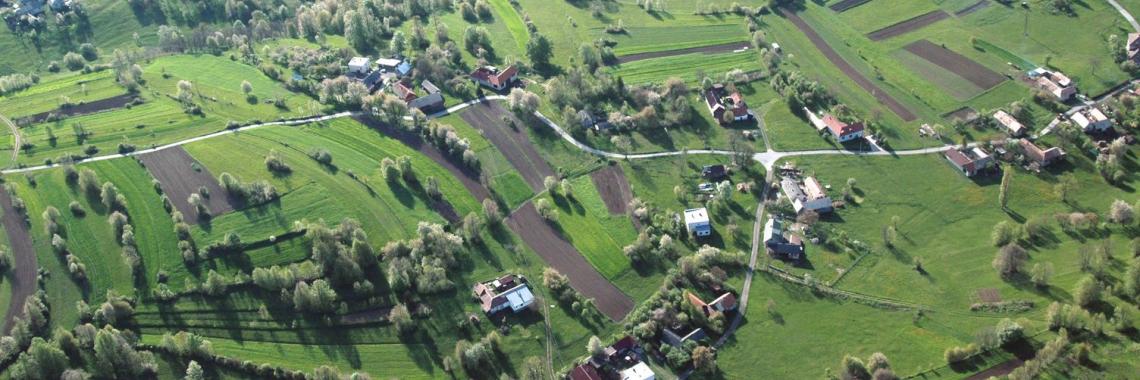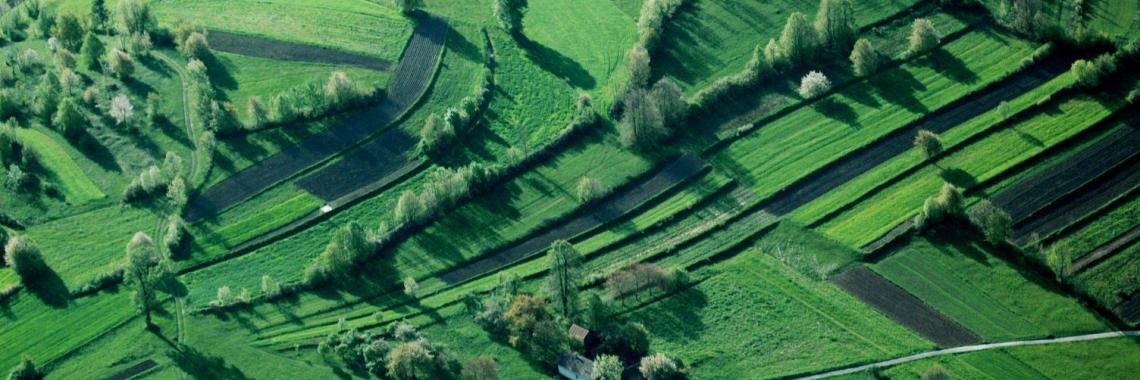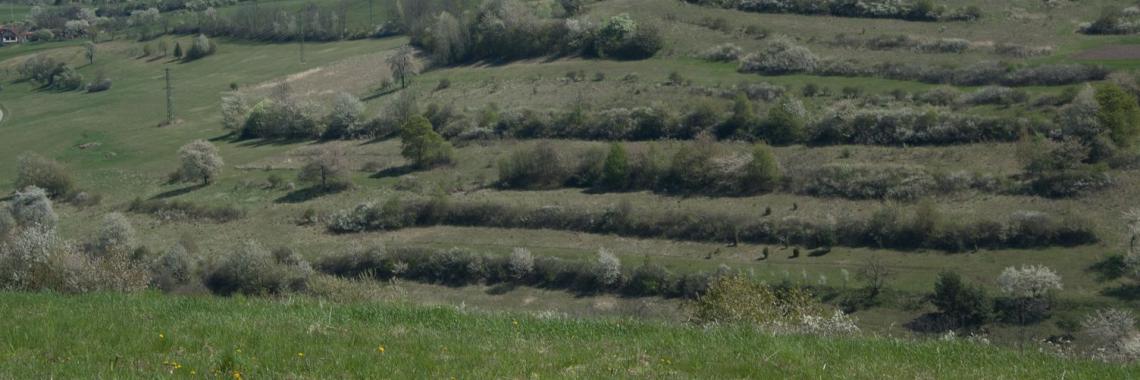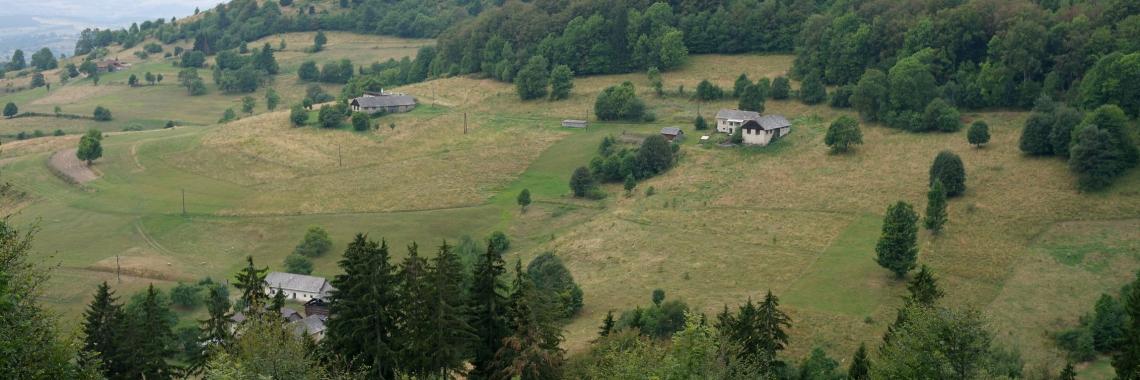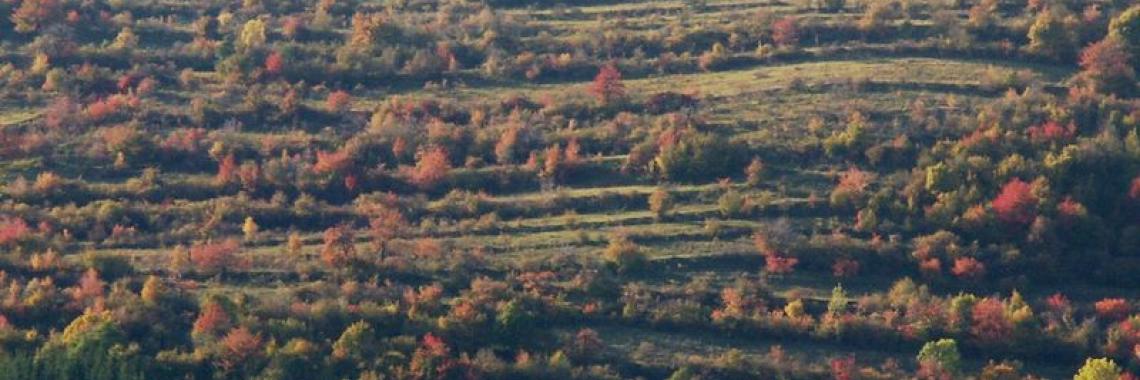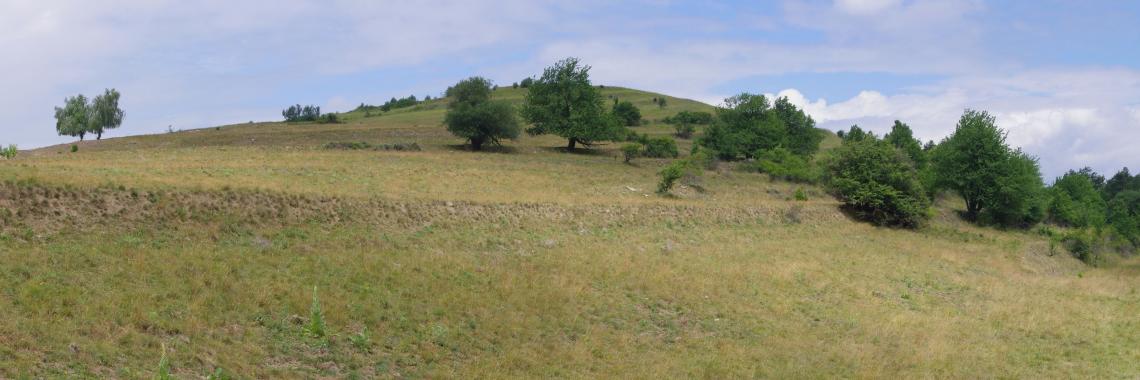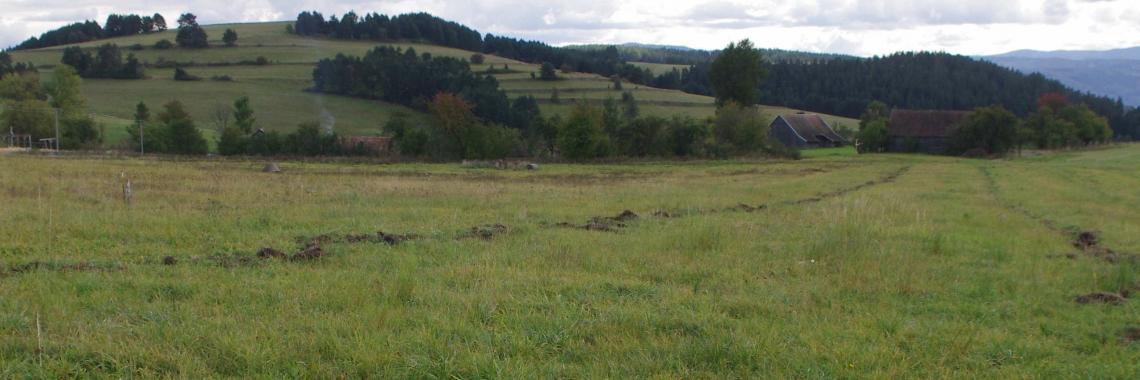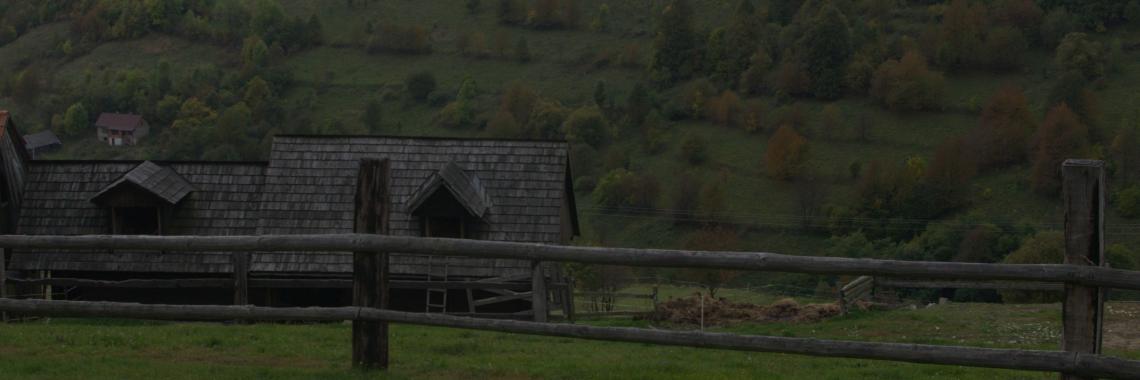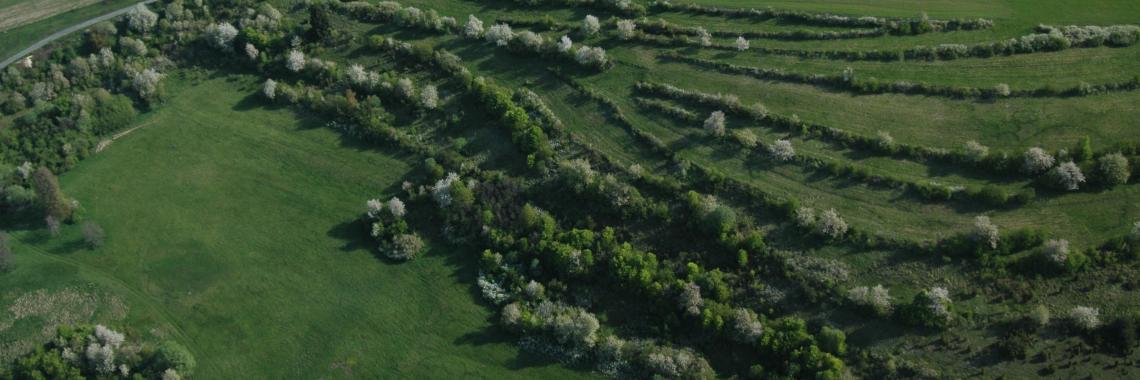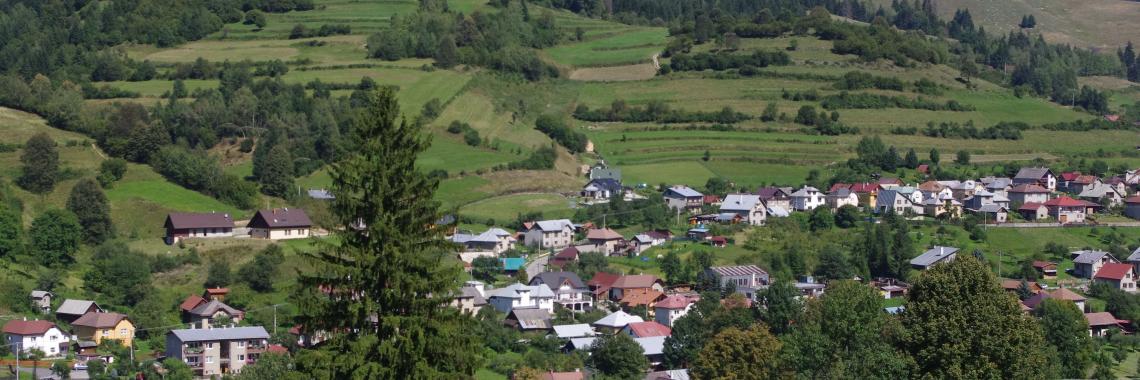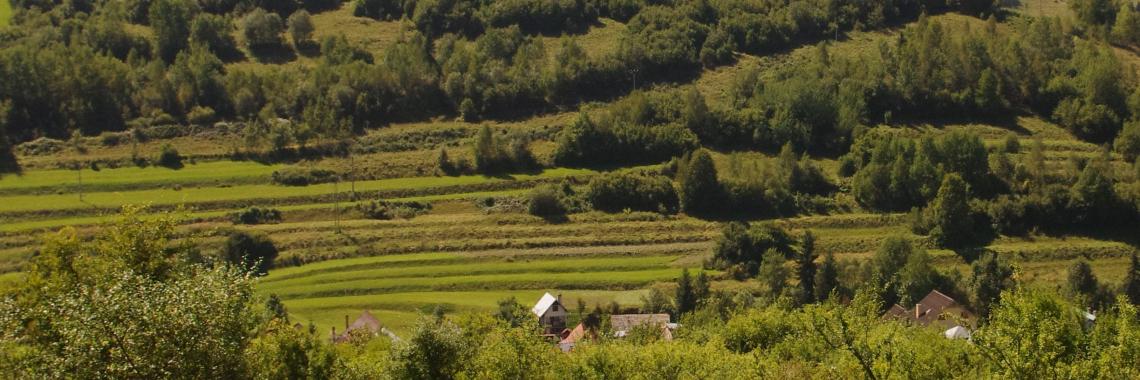Terraced landscapes in Slovakia
26.07.2017, by Bénédicte Gaillard
Research: Martina Slámová, Jana Špulerová, Marta Dobrovodská, Dagmar Štefunková; upload: Bénédicte Gaillard.
Terraces for agricultural land use were established primarily during the Walachian colonisation wave between the 14th and 16th centuries in Slovakia (Stankoviansky, 2003). They either arose spontaneously as a result of long-term plowing of linear plots on milder slopes or they were built intentionally on steeper slopes to prevent soil erosion and movement of sediments downslope during the storm situations (Stankoviansky, 2007).
Stankoviansky (2001) pointed out the plowing erosion to be the determinating process in a long-term modelling of landforms in agricultural landscape of uplands and is considered to be one of the most important soil degradation processes. A terrace field is the most frequent landform that developed after the contour ploughing.
Before the land consolidation reforms in Slovakia, the agricultural landscape was very heterogeneous as we document in Fig. 8 in cadastral area of Budiná. Ploughland on terraces and small fields on steep slopes were typical. These terraces and slopes often contained a substantial amount of wooded non-forest vegetation, barrier elements and dense networks of agrarian roads and pathways (Hanušin, 2003).
ČECH, V., KROKUSOVÁ, J. (2013): Antropogénna geomorfológia (antropogénne formy reliéfu). Vysokoškolská učebnica. University of Prešov, Prešov, 179 pp.
CHRASTINA, P. 2009. Landscape Use Development of Trenčín Basin and a Part of its Mountain Border. FF UKF, Nitra.
HANUŠIN, J., 2003. Landscape Ecological Aspects of the Collectivized Agricultural Landscape in View of Sustainability. Ekológia (Bratislava) 22, 367-376.
HRAŠKO, J., BEDRNA, Z. (1988): Aplikované pôdoznalectvo. Bratislava, Príroda.
HUBA, M., 2004. Historical Landscape Structures in Context to Contemporary Reality. The Environment 38, 86-89.
JANČURA, P., BOHÁLOVÁ, I., SLÁMOVÁ, M., MIŠÍKOVÁ P. 2010. Method of identification and assessment of characteristic landscape appearance. In Bulletin of the Ministry of Environment of Slovak Republic. Bratislava: MŽP SR, Vol. 18, Part 1b, 2-51. ISSN 1335-1576.
JANČURA, P., KUĽANDA, M., SLÁMOVÁ, M., CIHLÁROVÁ, R. 2010. Change of Characteristic Landscape Signs in Relation to Disappearance of Historical Landscape Structures in the Pieniny Mts. In: Pieniny-Zapora-Zmiany, Monografie Pieńinskie 2, Flexergis, Nowy Sącz, pp. 281-291.
KOČÍK, K., 2004. Characteristic of the Selected Segment of the Historical Landscape Structures in the Agricultural Landscape, Osturňa. In: Jančura, P., (Eds.), Historical Landscape Structures in Relation to Agricultural Land Use, Partner, Banska Stiavnica. pp.73-83.
LASANTA, T., ARNAEZ, J., RUIZ FLANO, P., LANARENAULT, MONREAL, N. (2013): Agricultural terraces in the Spanish Mountains: an abandoned landscape and a potential resource. Boletin de la Asociacion de Geografos Espanoles, 63: 487–491.
LIESKOVSKÝ, J., BEZÁK, P., ŠPULEROVÁ, J., LIESKOVSKÝ, T., KOLEDA, P., DOBROVODSKÁ, M., BÜRGI, M., GIMMI, U., 2015. The abandonment of traditional agricultural landscape in Slovakia – Analysis of extent and driving forces. In Journal of Rural Studies. ISSN 0743-0167. 2015, Vol. 37, p. 75–84.
LIESKOVSKÝ, J., KENDERESSY, P., ŠPULEROVÁ, J., LIESKOVSKÝ, T., KOLEDA, P., KIENAST, F., GIMMI, U. (2014): Factors affecting the persistence of traditional agricultural landscapes in Slovakia during the collectivization of agriculture. Landscape Ecology, Vol. 29, p. 867-877.
MACHOVÁ I., KUBÁT K. 2014. The species composition on agricultural terraces in NW part of Slovakia. Ekológia (Bratislava), Vol. 33, No. 4, p. 307–320.
MIKLÓS, L., HRNČIAROVÁ, T. [eds.] 2002. Landscape Atlas of the Slovak Republic. Bratislava, MŽP SR and Banská Bystrica, SAŽP, 344 pp.
SALY, R., 1962. The Main Types of Forest Soils in Slovakia. SAV, Bratislava
SLÁMOVÁ, M., BELÁČEK, B. 2004. Typology of Relief Shapes of the Historical Landscape Structures. In Jančura, P. eds. Historické krajinné štruktúry. Banská Štiavnica : Partner, 2004, p. 25-31. ISBN 80-89183-09-03.
SLÁMOVÁ, M., BELÁČEK, B., JANČURA, P., PRÍDAVKOVÁ, Z. 2015. Relevance of the Historical Catchwork System for Sustainability of the Traditional Agricultural Landscape in the Southern Podpolanie Region. In Agriculture and Agricultural Science Procedia, ISSN 2210-7843, 2015, no. 4, p.10–19.doi:10.1016/j.aaspro.2015.03.003
SLÁMOVÁ, M., JAKUBEC, B., HREŠKO, J., BELÁČEK, B., GALLAY, I. 2015. Modification of the potential production capabilities of agricultural terrace soils due to historical cultivation in the Budina cadastral area, Slovakia. In Moravian Geographical Reports. ISSN 1210-8812, 2015, Vol. 23, No. 2, p.47–55. DOI: 10.1515/mgr-2015-0010
SLÁMOVÁ, M., JANČURA, P., DANIŠ, D. 2013. Methods of Historical Landscape Structures Identification and Implementation into Landscape Studies. In Ekológia (Bratislava). ISSN 1335-342X. 2013, Vol. 32, No. 3, p.267 – 276. doi:10.2478/eko-2013-0023.
SLÁMOVÁ, M., JANČURA, P., KUĽANDA, M., JAKUBEC, B., 2008. Historical Landscape Structures of Ostrozky Mts.. In: Benčať, T., Jančura, P., Daniš. D. (Eds.), Selected Problems of the Sub-mountain and Mountain Landscapes, Partner, Poniky, pp. 61-68.
SPULEROVA, J., DOBROVODSKA, M., IZAKOVICOVA, Z., KENDERESSY, P., PETROVIC, F., STEFUNKOVA, D. 2013. Developing a Strategy for the Protection of Traditional Agricultural Landscapes based on Complex Landscape-Ecological evaluation (The Case of a Mountain Landscape in Slovakia). Moravian Geographical Report 21(4), 15-26.
ŠPULEROVÁ J., DOBROVODSKÁ M., LIESKOVSKÝ J., BAČA A., HALABUK A., KOHÚT F., MOJSES M., KENDERESSY P., PISCOVÁ V., BARANČOK P., GERHÁTOVÁ K., KRAJČÍ J., BOLTIŽIAR M. 2011. Inventory and classification of historical structures of agricultural landscape in Slovakia. Ekológia (Bratislava), Vol. 30, No. 2, p. 157–170, 2011.
ŠPULEROVÁ, JANA - PETROVIČ, FRANTIŠEK. Historical agricultural landscape as a subject of landscape ecological research. In Hrvatski geografski glasnik, 2011, vol. 73, no. 2, p. 155-163.
STANCHI, S., FREPPAZ, M., AGNELLI, A., REINSCH, T., ZANINI, E. (2012): Properties, best management practices and conservation of terraced soils in Southern Europe (from Mediterranean areas to the Alps): a review. Quaternary International, 265: 90–100.
STANKOVIANSKY, M., BARKA, I. (2007): Geomorphic Response to Environmental Changes in the Slovak Carpathians. Studia Geomorphologica Carpatho-Balcanica, 41, 5-28.
STANKOVIANSKY, M., 2003. Historical and Present Slope Evolution in Hilly Farmland (on the Example of the Myjava Hill Land, Slovakia). Supplementi di Geografia Fisica e Dinamica Quaternaria 6, 91–97.
STANKOVIANSKY M. (2001): Tillage erosion and its geomorphic effect with special regard to the Myjava-White Carpathian kopanitse area. Geografický časopis, 53 (2), 95-110.
ŠTEFUNKOVÁ, D., DOBROVODSKÁ, M., 2009. Preserved European cultural heritage in agrarian landscape of Slovakia. Tájökológiai Lapok 7, 283-290.
URBAN, P. 1999. Meeting of scientists in Ostrôžky, 1999 (in Slovak). Protected Areas in Slovakia. [online]. Source. Available from: http://www.sazp.sk/slovak/periodika/chus/42/page19.html [Accessed 14 October 2011]
VILČEK, J. (2007): Model of agricultural landscape categorization. Agriculture, 53(1): 31–37.
Traditional agricultural land use on terraces has persisted only locally, besides vineyards, mainly in submountain and mountain regions that are assessed as marginal from socio-economic point of view. Terraces are found in all types of traditional cultural landscapes in Slovakia that are classified in the Landscape Atlas of the Slovak Republic (Miklós and Hrnčiarová, eds., 2002). Terraces occur in the following types: traditional meadow-pasture landscapes, landscapes with traditional scattered settlements and traditional vineyards. As well as they locally exist in common intensively used agricultural landscape, they appear as fragments (Fig. 3).
The agricultural landscape is unique due to its preserved terraces and stonewalls which separate grassland parcels (Štefunková, Dobrovodská, 2009). Terraces delimit small-scale plots with ploughlands, grasslands (meadows, less pastures), vineyards and orchards. Unique are terraces combined with catchworks that were observed in the cadastral area of Hriňová (Fig. 10) (Slámová et al., 2015). They have been used in mixed agro-pastoral system, in the past locally with intensive agricultural activities, nowadays non-intensively used or suffering insufficient managements as we document in Fig. 5 and Fig. 6 in the cadastral area of Budiná.
As pointed out Machová and Kubát (2014) Agricultural terraces represent places of refuge for species that can spontaneously succeed in fallow fields. The structure of the vegetation on agricultural terraces is characterised by the high coverage of the herb layer and low or non-existent coverage of the shrub and tree layer. Forest herb species do not appear. Agricultural terraces are not biotopes with conditions different from those of the surrounding land. That is why it is understandable that the flora of the terraces and of the surrounding land is similar.
Besides regions with traditional vineyards and their terraces, a large amount of terraces lies in marginal and handicapped agricultural regions which have unfavourable natural conditions and geographical position (in relation to important residential-economic centres and communications). They occur in in less favourable higher altitudes (300-700 m A.S.L.), in cold and very cold and wet climatic regions.
Approximately 47% of agricultural soils in Slovakia have a prevailing rocky fraction (Hrasko, Bedrna, 1988). Cambisols typically occur in forests in Slovakia on moderate and steep slopes and are moderately or heavily skeletal. Cambisols are also typical in agricultural sub-mountainous and mountainous regions in Slovakia (Vilcek, 2007). These regions are rich in terraces. As Saly (1962) documented in his original study based on field research, this soil type is the most widespread forest soil in Slovakia and is related to the special bio-climatic conditions of the humid moderate and cold mountain regions (600-2000 m ASL). This soil also contains several subtypes and varieties that naturally vary from deep to shallow depths. Saly (1962) also commented on the broad variability of skeleton contents. The wide variability of cambisols is conditioned by the diversity of geological structures that interact with exogenous paedogenesis processes on the slopes.
No relationship was observed between soil cultivation and the soil depths during the research done by Slámová et al. (2015) (Fig. 14). Furthermore, authors did not observe any pronounced differences between the skeleton contents as defined in codes of the Basic Soil-Ecological Units classification of agricultural soils in Slovakia) and as evaluated in the soil samples. Our detailed analyses, however, indicated that the gravel fraction prevailed over the rocky fraction and that boulders were not present in the soil samples. Additionally, authors found substantial differences between the slope-grade data that were included in the potential production categories of the soil and the data that were collected in the field. According to our results, terraces have an optimal slope grade for arable soils (planes or gentle slopes with little to no risk of waterbased erosion). Thus, we concluded that human inhabitants have improved the soil conditions, primarily by removing the rocky fractions from agricultural terrace soils.
The modification of slope grades by terraces reduces the risk of water erosion processes, especially the erosion of finer fractions, and stabilises the soil profile. Favourable conditions for the removal of skeletons from soils and their accumulation on the edges of terraced fields are simultaneously generated (Spulerova et al., 2013).
The current socio-economic situation and demographic decline have resulted in the abandonment of traditional agricultural practices on terraces (Lieskovský et al., 2015)
Diversity of natural conditions, contiguity to Panonian regions and historic human activities correlate significantly with diversity of biotopes and it is the reason why agrarian terraces are very important for further biodiversity preservation in the region of the Ostrôžky Mt. (Urban, 1999), where we studied terraces in the Budiná cadastral area. Biotopes on the active mowed and grazed historic landscape structures (HLS) in the Budiná are protected as NATURA 2000 areas. Generally, agrarian support landscape diversity and biodiversity and developed typology of HLS by ÚKE SAV in Slovakia can help us to preserve significant biotopes in agricultural landscapes in the practice of landscape planning (Slámová et al., 2013).
Although Slovakia in 2005 adopted the European Landscape Convention (CoE, 2000) proclaiming the preservation and the maintenance of the Slovakian landscape types, historical agrarian structures with traditional management are not subject of any specific policies that would ensure their preservation. Even though some official documents partially or more focus on historical agricultural landscapes (Špulerová and Petrovič, 2011) existing laws provide insufficient protection (Slámová et al., 2013).
They are not related to any special architecture, products or religious or artistic aspects. Sometimes along with terraces are planted trees, usually fruit trees (besides vineyards) (Fig. 9 in cadastral area of Hriňová).
Traditional agricultural landscapes correspond with regions in Slovakia where strong feeling of traditions have persisted in human minds of locals. That reflects in folk fests and celebrations and everyday habits and customs (see attached web links).
Terraces are generally well known by public from local to regional level. Anyway touristic potential of terraces is not still efficiently used in Slovakia.
Due to their historical and aesthetic significance, terraces are a resource for agriculture and tourism; however, they also pose challenges for land conservation and management (Stanchi et al., 2012).
They are included in groups in frame of historic landscape structures classification: historical structures of agricultural landscape with dispersed settlement; historical structures of arable-land, grasslands and orchards; historical structures of arable-land and grasslands, vineyards (Špulerová et al., 2011). Anyway they are not defined especially as sub-type of mentioned groups.
They are subject of landscape and nature protection and are included in the category called historic landscape structures (HLS). The most important law that concentrates on HLS and characteristic features preservation in Slovakia is the Act of National Council of the Slovak Republic No. 543/2002 Coll. According to the act, we can preserve ‘characteristic landscape appearance’ and ‘significant elements of the landscape’. Terraces can be proclaimed as significant landscape elements in case they contain valuable biotopes and can be especially protected by cited law.
Method of ‘identification and assessment of characteristic landscape appearance’ (Jančura et al., 2010) has officially been adopted by the Slovak Ministry of the Environment as a tool for practical landscape planning and it was developed at the Department of Landscape Planning and Design at Technical University in Zvolen in co-operation with Slovak Environmental Agency in Banská Bystrica. The Method helps us to provide arguments for HLS preservation in landscapes where existing laws provide insufficient protection. The Method contains steps of quantitative geo-data processing and landscape’s attributes evaluation in GIS as well as steps for axiological attributes assessment. Visualisation tools are used for documentation of real landscape appearance. Very important are archive and field researches. We developed a simple catalogue (Slámová, Beláček, 2004) for identification of historic landforms in terrain.
Farmers can apply for financial compensation. Agri-environmental policy in Slovakia is concentrated on farmers’ activities to improve the rural landscape quality. The policy stimulates the co-operation of agrarians and nature conservation experts. The Rural Development Program (2007-2013) of the Slovak Republic (http://www.land.gov.sk) is a guaranteed financial management tool for improving the rural environment, the diversification and multi-functionality of the rural landscape and the support of competition in agricultural trade. As part of the program, financial compensation is provided as “agri-environmental payments” for agriculturally handicapped regions, NATURA 2000 areas and sub-mountainous and mountainous agricultural regions with difficult natural conditions. Thus, substantially covering all of regions with agricultural terraces (http://www.ivvl.sk/stmat/KrizPln2010.pdf).
Currently, agrarian terraces require external financial support for retention. Regions with naturally disadvantaged production are significantly supported by agri-environmental payments in Slovakia. We do not consider this manner of allocating subsidies to agriculture sustainable; however, agri-environmental payments are useful in the initial phases of agricultural revival. Historical agrarian terraces represent characteristic features of the landscape because these terraces support the heterogeneity and biodiversity of sub-mountainous landscapes (Fig. 4 in Budiná). Thus, we should preserve the diversity of European landscapes as a common resource of natural and cultural heritage, as defined by the European Landscape Convention (Council of Europe, 2000) that Slovakia adopted in 2005 (Slámová et al., 2015). The best example of the heterogenous landscape with terraces and active traditional agriculture is cadastral area of Hriňová (Fig. 1, 2).
Yes, they exist in submountain agricultural landscapes in Slovakia. These landforms represent a culturally valuable part of landscapes, and under a proper management they could play an important role in local development. Historical agricultural terraces rank among historical landforms, which are of particular importance in dating of the cultural landscape (Čech and Krokusová, 2013) because of their high temporal constancy. Agrarian terraces with traditional land uses represent historic landscape structures (HLS). HLS are distinguishable structures in current land cover structures that are older than 50 years (Jancura, et al, 2010). They are an integral part of land cover structures, have value and represent cultural heritage (Huba, 2004) as we document in the Hriňová cadastral area (Fig. 1, 2).
The period of agriculture collectivisation (1950s–1970s) is known as one of the most important periods in landscape development in Slovakia. Traditionally managed agricultural landscapes, which once covered more than half of the Slovak territory, were transformed into large-scale fields. Only fragments of traditional agricultural landscapes have survived (Lieskovsky et al., 2014). Transformation to large scale pastures and land abandonment we document in Fig. 7 in the cadastral area of Budiná. During this period terraces were destroyed or abandoned and further abandonment has begun after The Velvet Revolution in 1989 due to socio-economic regress in many regions and due to the withdrawal of locals to work abroad as we document on the example of Horný Tisovník cadastral area (Fig. 11, 12).
We studied terraces as landforms as well as soil conditions and production functions in the cadastral area of Budiná (Slámová et al. 2015) (Fig.14). Terraces are a valuable feature of the cultural landscape of the Budiná cadastral area (Slamova et al., 2013). Terracing is used worldwide and they are classified into different categories. Lasanta et al. (2013) defined bench terraces, in which the flat area is delimited in the lower part by a vertical step (a stone or talus wall covered by shrubs or fruit trees). The second type of terrace is represented by small slope gradients that are delimited by herbaceous vegetation or a wall made from stones that were removed from the field. Both study areas (Budiná and Horný Tisovník) were rich in contoured hillside terraces (Fig. 13).
Distribution of terraces in relation to natural conditions and settlements was investigated in the cadastral area of Horný Tisovník where we documented both types of terraces. Frequent were terraces with small gradient and approximately the same amount represented bench terraces without plants (Fig. 15a), as well as terraces which were made as a wall from stones that were probably removed from cultivated fields (Fig. 15b).
Research on slope grade modification due to agricultural activities has been performed in other localities in Slovakia. Terraces in Osturna, which is located in the cadastral area of northeastern Slovakia, have an average slope grade of approximately 11° (Kočík, 2004), and in Horny Tisovnik, which is located in the Ostrozky Mts., the average slope grade for terraces is 14° (Slámová et al., 2008). The critical slope grade for agricultural soil utilisation is 12°.
Chrastina (2009) discussed the sustainability of the agrarian economy in a locality situated in the Biele Karpaty Mts. Terraces protected the soil from erosion processes on slopes with a grade of 12-17°; however, these terraces were destroyed during land consolidation reforms in the 1970s to achieve larger fields with more arable land, which resulted in ploughland decay. Accelerated erosion processes on slopes have begun. Finally, badly eroded land has been re-cultivated by wooded non-forest vegetation or by grasslands.
Terraces are historic landforms and artefacts occurring in all types of historic agricultural structures that classified Špulerová et al. (2011): historical structures of agricultural landscape with dispersed settlement; historical structures of arable-land, grasslands and orchards; historical structures of arable-land and grasslands; historic structures with vineyards.
We document traditional landscapes in Slovakia in Fig. 16 and investigated cadastral areas with terraces in Fig. 17 were the field research was done between 2008-2013.

